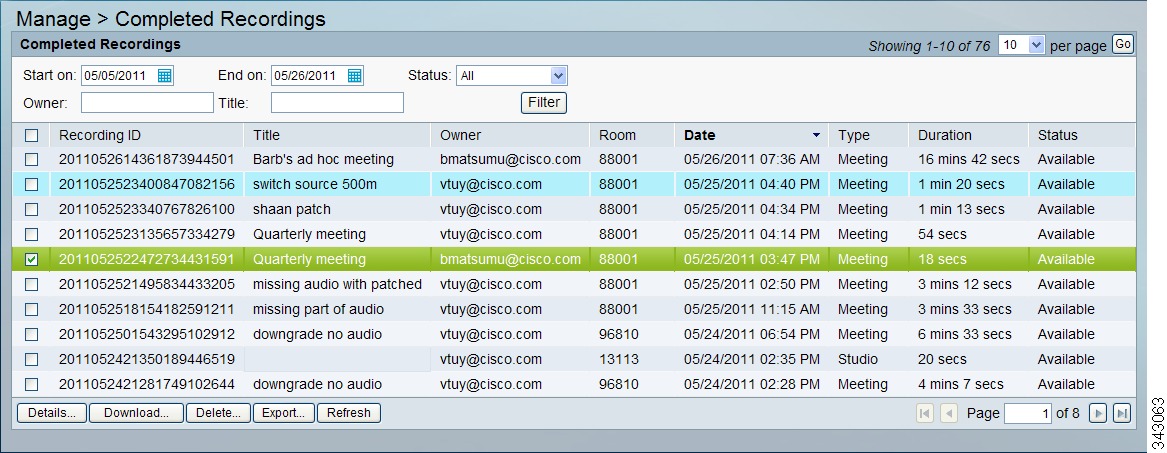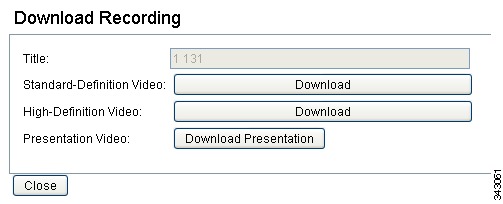

Table Of Contents
Exporting Recordings from the Completed Recordings List
Downloading a Recording to Your Computer
Managing CTRS Recordings
October 2011The Cisco TelePresence Recording Server (CTRS) stores and enables you to manage recordings created by the following sources:
•
Cisco TelePresence Studio Mode
•
Event Recording
The following sections describe the CTRS Recordings Management features. Recordings Management is divided into the following areas:
–
Exporting Recordings from the Completed Recordings List
–
Downloading a Recording to Your Computer
Active Recording
Click Active Recordings in the left menu to display all recordings that are currently being created (see Figure 5-1).
Figure 5-1 Manage > Active Recordings
The Active Recordings page displays a table that lists the following information about recording sessions that are currently in progress:
•
To stop a recording in progress, click Stop.
•
To refresh the information displayed, click Refresh.
Completed Recordings
Click Completed Recordings in the left menu to display completed recordings (see Figure 5-2).
Figure 5-2 Manage > Completed Recordings
Use the Completed Recording page to view or edit a list of all completed recordings that are currently stored on CTRS.
To filter entries in the Completed Recordings table:
Step 1
Click the calendar icon to the right of the Start on: text box to display a calendar. Click the beginning date for filtering completed recordings information.
Step 2
Click the calendar icon to the right of the End on: text box to display a calendar. Click the ending date for filtering completed recording information.
Step 3
Choose the appropriate value from the Status drop-down list. Choices are:
•
All
•
Available
•
Delete Pending
Step 4
To filter using the owner of a recording, enter the owner name in the Owner text box.
Step 5
To filter using the title of a recording, enter the recording title in the Title text box.
Step 6
Click Filter.
Completed Recordings displays a table providing the following information about completed recordings, as described in Table 5-2:
•
To refresh the list of displayed recordings, click Refresh.
•
To delete a recording, check the box for that recording and then click Delete.
•
To see details about a recording, check the box for that recording and then click Details. CTRS displays the following information about the recording, as described in Table 5-3. After viewing details about the recording, click Close to return to the Complete Recordings window.
Exporting Recordings from the Completed Recordings List
You can export recordings to a specified archive server. To export recordings, do the following:
Step 1
Check the box for the recording(s) that you want to export.
Step 2
Click Export. CTRS displays a table listing all of the recordings you selected for export.
Step 3
Choose the appropriate export destination server from the Export to: drop-down list.
Step 4
Click Export.
Note
For more information about configuring export destination servers, see the "Archive Servers" section of this guide.
Note
When you export recording files, they remain on the CTRS. To delete recordings, check the boxes next to the recordings. Then click Delete.
Downloading a Recording to Your Computer
You can download the standard definition (SD) or high definition (HD) version of a recording to your computer. For a recording made using Event Recording, you can also download the presentation materials displayed during the meeting.
Because of video resolution changes, recordings made using Event Recording could be stored in multiple files. Before downloading multiple files to your computer, the CTRS transcodes the files into one file, which can be a lengthy process.
To download, do the following:
Step 1
Check the box for the recording that you want to download.
Step 2
Click Download.
The Download Recording dialog box appears as shown in Figure 5-3.
Figure 5-3 Download Recording Dialog Box
Step 3
Decide which version of the recording you want to download, and click the corresponding button.
If the Process File for Download button appears, the recording was written to multiple files, which must be transcoded into one file then downloaded. The transcoding process can be lengthy; therefore, a percentage complete counter provides an update of the progress.
Step 4
After the download is complete, click Save in the dialog box that appears, and specify where you want to save the file on your computer.

 Feedback
Feedback


